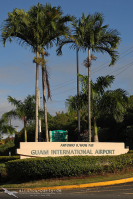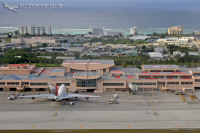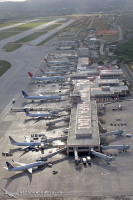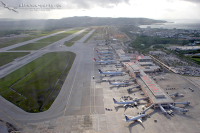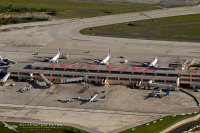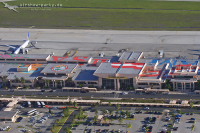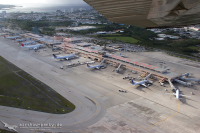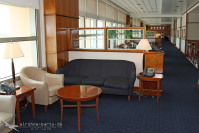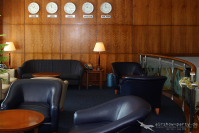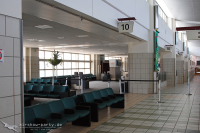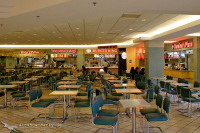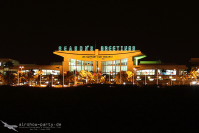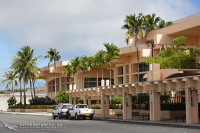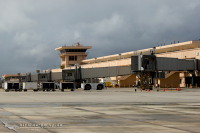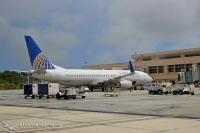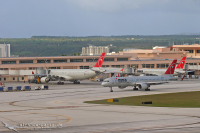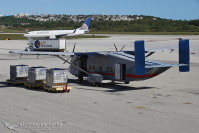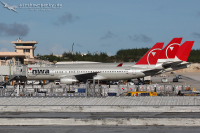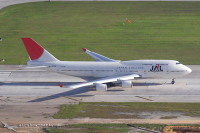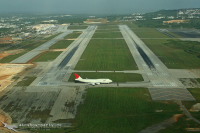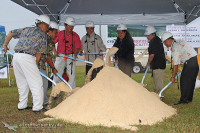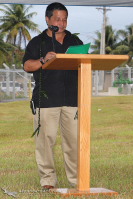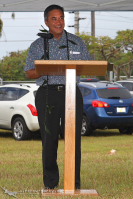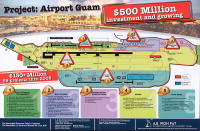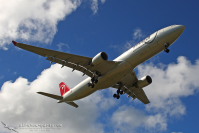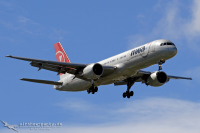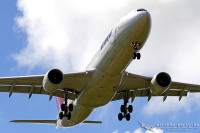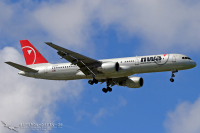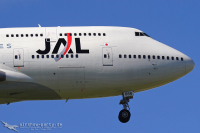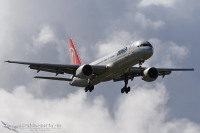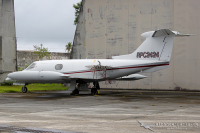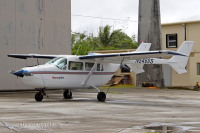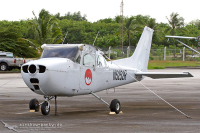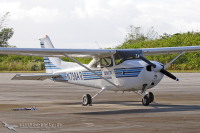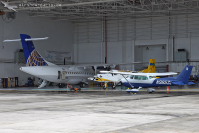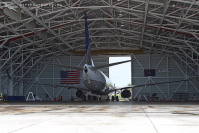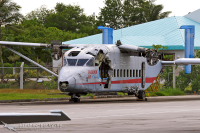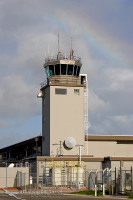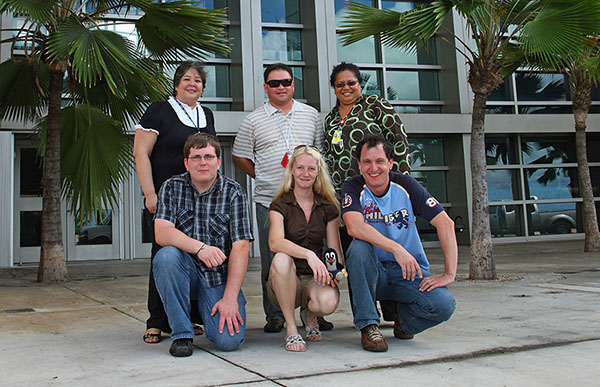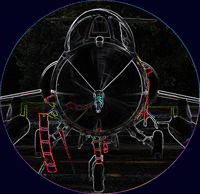
| Team |
| Events 2009 |
| Events 2008 |
| Events 2007 Events 2006Events 2005 |
| Videos |
| Publications |
| Gästebuch |
| Links |
| InternImpressum |

A.B. Won Pat International Airport, Guam, USA - GUM/PGUM
„Where americas day begins“, der Slogan des tropischen Inselparadieses lässt schon Rückschlüsse auf seine Lage erkennen: Guam liegt direkt vor den Toren Asiens, mitten im Pazifik und ist damit das östlichste Gebiet der USA.
Bekannt wurde das rund 175.000 Einwohner zählende Eiland besonders durch die Andersen AFB, welche der USAF als vorgeschobene Bomberbasis dient.
Der nach dem ersten Abgeordneten im US-Repräsentantenhaus benannte Zivilflughafen ist besonders Japanern ein Begriff, bedeutet er für diese, größte Touristenschar doch das Tor ins steuerfreie Shopping-Paradies.
Nachdem der Flugplatz als Naval Air Station im 2. Weltkrieg entstanden war, diente er bis 1969 ausschließlich militärischen Zwecken. Mit Gründung der Guam International Airport Authority 1975 und der Eröffnung des ersten Passagierterminals sieben Jahre später nahm der Zivilverkehr Fahrt auf. 1995 schließlich zog sich das Militär völlig zurück, besitz aber bis heute weitreichende Nutzungsrechte. Mit der Eröffnung des großen Terminalgebäudes im Jahre 1998 nahm der Flughafen seine heutige Gestalt an.
Heute ist A.B. Won Pat mit seinen über 6000 Angestellten ein wichtiger Faktor des Wirtschaftswachstums auf Guam und Amerikas Tor nach Asien. Er fungiert für Continental und Nortwest Airlines als Hauptdrehkreuz in dieser Region, US intern liegt der Platz auf Rang der der internationalen Ankünfte. Durchschnittlich 35 Flüge, davon alleine 23 von Continental, erreichen die Insel täglich in drei Wellen (0200h-0700h; 1000h-1200h; 1400h-1630h). Die 22 Ziele in sieben Ländern werden bevorzugt mit großem Fluggerät wie Boeing 747 und Airbus 330 bedient. Ihnen entstiegen im Jahr 2007 1.171.440 Touristen, 80% aus Japan, verschwindend geringe 0,3% aus Europa. Dazu gesellten sich noch 190.000 Transitpassagiere und über 18.000 Tonnen Fracht.
Der Airport Authority investierte in den vergangenen Jahren 5.8 Mio. $ in ein neues Airfield Lighting System und beide Bahnen verfügen über ILS. Trotz des Korean Air Unfalls 1997 gilt der A.B. Won Pat als äußerst sicher.
Ein großes Problem für den Airport ist die Tatsache, dass die ankommenden und abfliegenden Passagiere nicht durch bauliche Maßnahmen getrennt sind. Neue Verordnungen, welche nach 2001 nötig wurden, werden umständlich mit mobilen Stellwänden umgesetzt. Besonders in den Stoßzeiten kommt es dadurch zu Behinderungen, welche gelegentliche Verspätungen nach sich ziehen.
Die Zukunft de Flughafens erscheint äußerst positiv. 2009 wird die Landebahnverlängerung auf 12.000ft Direktflüge auf das amerikanische Festland möglich machen und ein Jahr später eröffnet ein modernes, 3252qm großes, 4 Mio.$ teures Cargoterminal. In Hinsicht darauf, dass ab 2010 8000 Marines und ihre Familien von Okinawa/Japan nach Guam verlegt werden, will Continental das Drehkreuz A.B. Won Pat weiter ausbauen. Es wird erwartet, dass bis 2012 die Passagierzahlen jährlich um über 2 % steigen werden. Bei einer höchst möglichen Auslastung von 5000 Passagieren pro Stunde sollte der Flughafen hierfür bestens gerüstet sein.
Unser Dank gilt Rolenda Faasuamalie von der GIAA und ihrem Team für die umfangreiche Airporttour, den zahleichen Informationen und die Teilnahme an der Grundsteinlegung des neuen CTSI Terminals.
English:
„Where America’s day begins“, the slogan of the tropical island paradise already reveals inferences on its situation: Guam is located directly at the gates of Asia, in the middle of the Pacific and so it is the most eastern area of the USA. The island with about 175,000 inhabitants became especially popular through the Andersen AFB which serves as advanced bomber base. The civil airport, named for the 1st delegate from Guam to the United States House of Representatives, is well known by Japanese and means for this, the biggest tourist crowd, the gate to a duty-free shopping paradise.
After the airfield had developed as Naval Air Station in WW II it served until 1969 exclusively military purposes. With foundation of Guam International Airport Authority in 1975 and the opening of the first passenger's terminal seven years later the civil traffic accelerated. Finally, in 1995 the military completely withdrew, however, owns till this day far-reaching rights of use. With the opening of the big terminal building in 1998 the airport took its today's shape.
Today A.B. Won Pat is with its more than 6000 employees an important factor of the economic growth on Guam and America’s gate to Asia. The airport acts as hub for Continental and Northwest Airlines in this region, US internal it is on rank 8 of international arrivals. Average 35 flights, 23 of that from Continental arrive at the island daily in three periods (2 am-7 am; 10 am-12 pm; 2 pm-4.30 pm). Twenty-two destinations in seven countries are preferentially served by big aircrafts like Boeing 747 and Airbus 330. In 2007 came 1,171,440 tourists, 80% from Japan, infinitesimal 0.3% from Europe. In addition to that came 190,000 transients and more than 18,000 tons cargo.
The Airport Authority invested $5.8 million in the past years into a new Airfield Lighting System and both runways are equipped with ILS. In spite of the accident of Korean Air in 1997 A.B. Won Pat is deemed to be exceeding safe.
A big problem for the airport is the fact that there’s no division between arrival and departure passengers by structural measures. New regulations, which are necessary since 9/11, are realized circumstantially with movable walls. Especially during rush hour delays happen.
The future of the airport seems extremely positive. In 2009 the runway lengthening up to 12,000ft will make possible direct flights to the US mainland and one year later a modern, 3252m² big, $4 million cargo terminal will open. In view of 8000 marines and their families who will move from Okinawa, Japan to Guam in 2010 Continental wants to expand the capacity of A.B. Won Pat. It is expected that the passenger volume will rise yearly by 2% until 2010. With the highest possible capacity of 5000 passengers per hour the airport should be prepared for this very well.
Many thanks to:
Rolenda Faasuamalie from the GIAA and the CTSI
